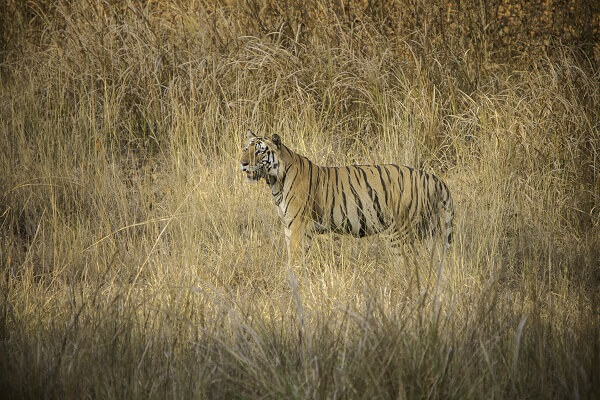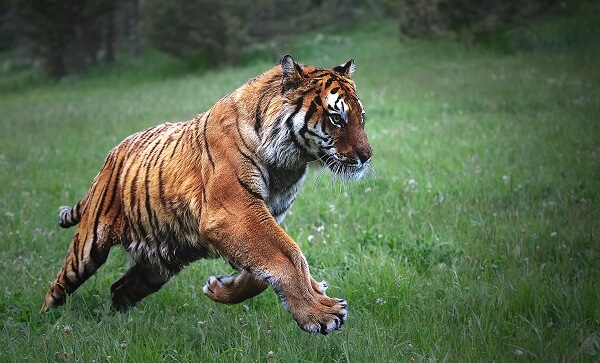
The Bengal tiger (Panthera tigris tigris) – also known as the Royal Bengal tiger or the Indian tiger – is a subspecies of tiger found mainly in India. However, they are also found in Bhutan, Nepal, Myanmar, Bangladesh, and China. It is the most common of the tiger subspecies and accounts for more than half of all tigers left in the wild. About 3,400 Bengal tigers remain in native habitat. Bengal tigers are primarily solitary animals. They scent-mark vast territories to warn rivals to stay away. These tigers are nocturnal hunters and can travel many miles to find their prey. They mainly hunt buffalo, deer, wild pigs, and other large mammals. A hungry tiger can eat as much as 60 pounds in one night, although they usually eat less. When tigers aren’t hunting, or on the move, they are most likely to be sleeping. These big cats can sleep between 16 and 18 hours a day! Females can give birth to a litter every two years. She can have up to seven cubs, but usually only two survive. The female looks after the cubs with little or no help from the male and can’t kill enough to feed them all. Aside from hunger, cubs can also succumb to illness and accidents. The cubs remain with the female for two to three years, when they then leave to find their own territory. Up to this point, the mother takes care of them, teaching them how to hunt and survive. Cubs often hone their skills by fighting and wrestling with each other, as well as practicing their ambush on their resting mother. The biggest threat to Bengal tigers come from humans. As the human population grows, the forests are becoming smaller and fragmented, reducing their natural habitat. This can mean that the tigers have less food to hunt through diminishing habitat or because they compete with humans for the same prey. Humans also sometimes hunt tigers, even though this is often illegal as tigers are protected in many areas. Tigers will mostly avoid humans, although a few have become dangerous to man. This is usually because the animals are sick or because they are in an area where their traditional prey has vanished. Tigers are the largest member of the cat family and are known for their power and strength. These powerful predators have a number of biological adaptations that make them very successful hunters. Tigers can be found in forests or jungle areas with lots of trees and long grass. As the sunlight filters through the trees and grass, shadows are created. The pattern of the tiger’s fur matches the shadows allowing the cats to blend into their environment. The stripes also work to break up the tiger’s body shape, which also helps them to be camouflaged amongst the trees and grass. Camouflage is used by several animals to hide from predators or sneak up on prey. The type of camouflage used by the tiger is known as disruptive camouflage, where the color patterns make it difficult for other animals to see the outline of the tiger’s body. By blending into their environment, tigers can sneak up on their prey and lie in wait ready to pounce. There are several other types of camouflage. The most common is background matching, or concealing coloration, where the animal blends in with its surroundings. For example, squirrels are usually brown to blend in with the earth colors of their habitat, and flounders are colored to blend in with their seafloor habitat. Aside from orange and black, these tigers can also be black with tan stripes, all white (albino), or white and tan. White Bengal tigers are a rarity and occur because of a gene mutation. The stripes on a tiger are like human fingerprints, no two tigers have the same stripes, and so this pattern of stripes can be used to tell tigers apart. Tigers have incredibly sharp hearing and communicate in booming low-frequency sounds. Researchers have found that tigers hear and communicate using infrasound, which are soundwaves that are below the range of sounds that can normally be heard by most species (20 hertz). Infrasound is mostly inaudible to humans. Tigers use these low sounds to make their presence known, whether its to scare away rivals or to attract a mate. Low-frequency sounds carry better than high-frequency sounds, enabling tigers to communicate over long distances or through dense forest vegetation. Other large animals such as whales, elephants, and giraffes use infrasound to communicate over large distances. Tigers have several physical adaptations that make them very efficient hunters. Their strength and muscular structure make them extremely fast runners and excellent swimmers. Tigers are so fast that they have been recorded as reaching speeds of up to 60 km per hour! Their flexible spines and long hind limbs allow them to jump up to 33 ft in a single jump. This allows them to lie in wait and creep close enough to attack, quickly pouncing on their prey and surprising them. They also have razor-sharp retractable claws. They use their claws to fight each other, maim and kill their prey, and to climb trees.
Kingdom
Animalia
Phylum
Chordata
Class
Mammalia
Order
Carnivora
Family
Felidae
Genus
Panthera
Species
Panthera tigris
Subspecies
Panthera tigris tigris
Length
Head and body is 5 – 6 ft (1.5 – 1.8 m), tail is 2 – 3 ft (0.6 – 0.9 m)
Weight
250 – 500 lbs (113 – 227 kg)
Lifespan
8 – 10 years in the wild
Social Structure
Solitary
Conservation Status
Endangered
Preferred Habitat
Dense forest and jungle
Average Litter Size
2 – 6 cubs
Main Prey Species
Buffalo, deer, wild pigs, and other large mammals
Main Threats
Humans
The Basics

Interesting Insights from the Bengal Tiger!
Striped fur makes them camouflaged

Tigers Communicate Using Infrasound

Tigers have Immense Physical Strength
